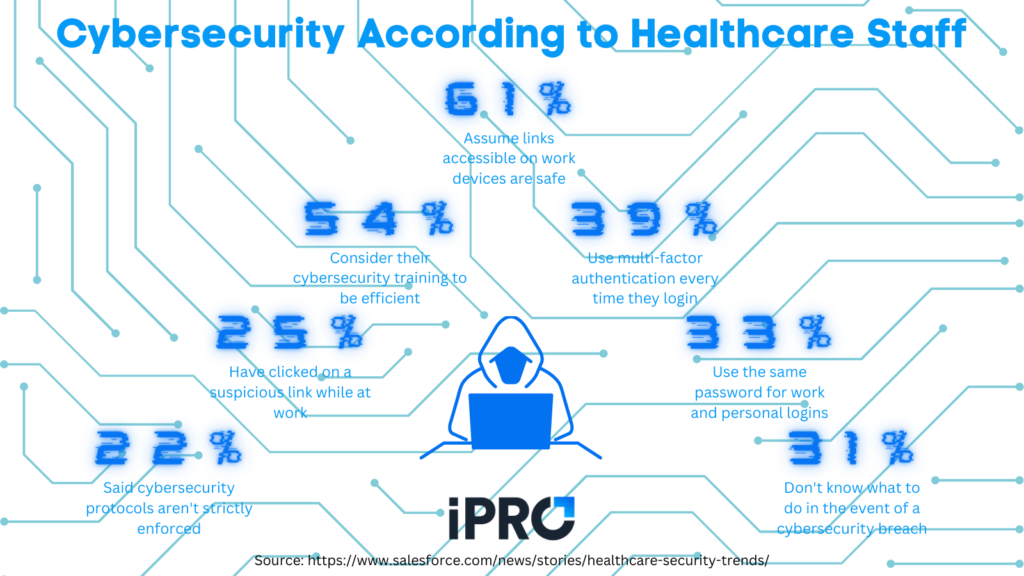(This article was originally published 5/24/23 and last updated 3/8/2024)
June is National Safety Month, a great opportunity to review your patient safety initiatives and focus on improving them. While a new Leapfrog report shows that patient safety has improved over the last decade, there’s still more work to do. In this blog, we’ll look at three ways healthcare providers can improve patient safety:
- Implement cybersecurity best practices
- Streamline the prior authorizations process, and
- Ensure medical imaging is safe and efficient
Implement Cybersecurity Best Practices
A recent report found that ransomware attacks on U.S. hospitals have doubled since 2016. While a patient death has yet to be officially attributed to a cyber attack on a hospital, cybersecurity breaches can impact patient safety in a number of ways:
- Care delays due to systems being locked/offline
- Incorrect medication doses being administered
- Changes in patients’ vital signs going unnoticed
- Physical threats such as intruders due to security systems being down
For these reasons and more, it’s imperative that hospitals implement cybersecurity best practices to prevent cybersecurity breaches and attacks. A recent Salesforce survey of healthcare workers’ views on cybersecurity revealed more work needs to be done to improve cyber awareness among healthcare staff. Notable responses from the survey include:
- 22% of respondents said cyber security protocols are not strictly enforced
- 31% don’t know what to do in the event of a cybersecurity breach
- Only 54% consider their workplace’s cybersecurity training to be efficient
- Only 39% use multi-factor authentication every time they login
- 25% have accidentally click on a suspicious link at work
- 33% use the same passwords for both work and personal accounts
- 61% assume that if they can access a site on their work device, the link must be safe

To address these issues, healthcare providers should implement and enforce cybersecurity best practices, such as:
- Ensure employees receive adequate and up-to-date cybersecurity training at regular intervals
- Provide a cybersecurity handbook detailing how to recognize and prevent cybersecurity threats and what to do in the event of a suspected breach
- Require multi-factor authentication for work-related logins
- Strictly enforce cybersecurity protocols, such as requiring passwords to be changed frequently and prohibiting the use of personal devices for work-related tasks
- Review the organization’s cybersecurity protocols at least annually and update them accordingly
Streamline the Prior Authorizations Process
The prior authorizations process is not only a burden for physicians. It also poses serious safety risks for patients. In a recent survey conducted by the American Medical Association, 94% of physicians said that prior authorizations resulted in care delays at least sometimes, with 56% answering “often” or “always.” According to 80% of physicians, issues with the PA process lead to abandoned care at least sometimes, and 28% answered “often” or “always.”
What does this mean for patient safety? Delayed care can have a snowball effect on a patient’s health. For example, a delayed hip replacement can lead to a lack of mobility, which could result in the patient becoming obese, leading to a host of chronic illnesses such as:
- diabetes
- heart disease
- high blood pressure
- high cholesterol
- osteoarthritis, and
- stroke

In the case of prior authorizations, 33% of physicians surveyed by the AMA reported that PA has led to a serious adverse event for a patient in their care. These serious events range from hospitalization (25%) to permanent damage/disability including birth defects or death (9%).
While it may take government intervention to fully overhaul the prior authorizations process, healthcare providers can improve patient safety by streamlining the process. Consider outsourcing your PA process to alleviate the burden from your staff as well as speed up approvals.
Ensure Medical Imaging is Safe and Efficient
Our final tip to improve patient safety is to ensure medical imaging is safe and efficient. Whether it’s radiology, mammography, or cardiology, medical imaging plays a major role in patient safety and health outcomes. For one, it’s important to track patients’ radiation exposure. Dose monitoring software, like Novarad’s NovaDose, helps ensure patients aren’t exposed to excessive radiation. NovaDose provides alerts based on a customer-defined dose threshold when a test is ordered. Alerts based on historical dose information from a patient’s dose profile are triggered upon exam order and broadcast via email or to the RIS, HIS, etc.
Efficiency in medical imaging can also help improve patient safety. Proper workflow management can speed up reading and reporting times, ensuring patients get the care they need in a timely manner. AI-assisted imaging analysis can also help detect cancer faster. Finally, imaging solutions that offer remote reading, reporting, and image sharing can ensure imaging specialists can still do their jobs in the event of a pandemic or natural disaster.
Building Trust by Improving Patient Safety and the Patient Experience
Patient safety should be a top priority for all healthcare providers. While patient safety metrics have improved over the years, following the three strategies discussed in this blog can further bolster patient safety. To recap, the three tips are:
- Implement cybersecurity best practices
- Streamline the prior authorizations process
- Ensure medical imaging is safe and efficient
Through our Novarad South brand, we offer an entire suite of medical imaging solutions that help improve patient safety and make imaging departments more efficient. Our solutions include:
- PACS
- RIS
- Mammography
- Cardiology
- Dose monitoring, and more
To learn more about how we can improve patient safety, reduce burnout, and increase revenues, read about Novarad South’s clinical solutions today.
Improving patient safety not only benefits patients. It also builds trust between patients and providers, resulting in a better patient experience and increased patient loyalty. For more tips on building trust and improving the patient experience, download our free infographic featuring Medscape’s 10 Tips for Improving the Patient-Physician Relationship.




